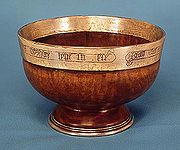
Mazer (drinking vessel)
Encyclopedia

Germanic peoples
The Germanic peoples are an Indo-European ethno-linguistic group of Northern European origin, identified by their use of the Indo-European Germanic languages which diversified out of Proto-Germanic during the Pre-Roman Iron Age.Originating about 1800 BCE from the Corded Ware Culture on the North...
tradition, a mazer is a special type of drinking vessel, properly made of maple
Maple
Acer is a genus of trees or shrubs commonly known as maple.Maples are variously classified in a family of their own, the Aceraceae, or together with the Hippocastanaceae included in the family Sapindaceae. Modern classifications, including the Angiosperm Phylogeny Group system, favour inclusion in...
wood, and so-called from the spotted or birdseye marking on the wood (Ger. Maser, spot, marking, especially on wood; cf. measles).
Description
These drinking vessels are shallow bowls without handles, with a broad flat foot and a knob or boss in the centre of the inside, known technically as the print. They vary from simple, wooden affairs, to those ornamented with metalwork.They were made from the 11th
to the 16th centuries, and were the most prized of the various wooden cups in use, and so were ornamented with a rim of precious metal, generally of silver or silver gilt; the foot and the print being also of metal. There are examples with wooden covers with a metal handle, such as the Flemish and German mazers in the Franks Bequest in the British Museum
British Museum
The British Museum is a museum of human history and culture in London. Its collections, which number more than seven million objects, are amongst the largest and most comprehensive in the world and originate from all continents, illustrating and documenting the story of human culture from its...
. On the metal rim is usually an inscription, religious or bacchanalian, and the print was also often decorated. The later mazers sometimes had metal straps between the rim and the foot.
A few were turned very finely, normally from burr maple (Acer campestre). Both the wood and the vessels made of it were known as "mazer" so in contemporary accounts sometimes they are referred to as ciphis de mazer (drinking bowl of burr maple wood) and sometimes simply as a "mazer". The best mazers had silver or silver gilt rims added, commonly prints were also added (a decorated disc in the base of the bowl) and occasionally normally on later mazers a silver or gilt foot was also added.
Surviving examples
About 63 medieval mazers are known to survive, and show the evolution of the mazer from a plain, wooden implement, to those with decorative rims. 13th and 14th century rims tend to be simple plain rims only about 1 cm deep without lettering, 15th and 16th century rims are very characteristic with a very deep (3–4 cm moulded form) often with lettering. One exception to this rule is the mazer which Samuel PepysSamuel Pepys
Samuel Pepys FRS, MP, JP, was an English naval administrator and Member of Parliament who is now most famous for the diary he kept for a decade while still a relatively young man...
drank from in 1660 (on display in the British Museum
British Museum
The British Museum is a museum of human history and culture in London. Its collections, which number more than seven million objects, are amongst the largest and most comprehensive in the world and originate from all continents, illustrating and documenting the story of human culture from its...
), the rim of this mazer is hallmarked 1507/8 but it is of the earlier simple form. The best collection on display is at the Museum of Canterbury, where 10 13th and 14th century mazers are shown. A very fine mazer with silver gilt ornamentation 3 inches deep and 9 1/8 inches in diameter was sold in the Braikenridge
George Weare Braikenridge
-External links:* * * *...
collection in 1908 for £2,300. It bears the London hall-mark of 1534.

